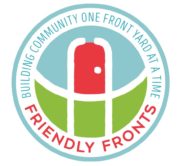Small Home Gazette, Summer 2016
Friendly Front Yards
 It’s a beautiful day in this neighborhood,
It’s a beautiful day in this neighborhood,
A beautiful day for a neighbor.
Would you be mine?
Could you be mine?
If you were mine, would I know you neighbor? Odds aren’t great. Sorry, Mr. Rogers. About one third of Americans say they have never interacted with their neighbors, according to City Observatory—an urban-policy think tank. Studies show that not knowing your neighbors creates a general distrust of others, as well as a lack of understanding of other people. In the heyday of the bungalow, families were outside interacting with their neighbors more, whether to walk to school or corner markets, or to take public transportation to work. People in bungalow neighborhoods saw each other more; neighbors talked more.
In his book The Vanishing Neighbor: The Transformation of American Community, Marc Dunkelman, a Brown University policy researcher, talks about “middle ring” relationships—“relationships that are familiar, but not intimate.” He notes that American communities have lost their ability to associate with people who are different, caused in part by the growth of expansive, segregated suburbs. “Americans, even if they didn’t like their neighbors, they understood them.”
St. Paul resident Max Musicant wants to bring back a sense of neighborly connection. He believes we can do it by moving ourselves outside, into our front yards, and inviting others to join us. To foster space outside our homes for casual greeting and gathering, Musicant created the free, online Friendly Fronts Toolkit (friendlyfronts.com).
The toolkit breaks down a front yard project plan into three parts:
1. Activity: Provide activities so people linger.
2. Edge: Build dynamic property edges to show the yard as welcoming.
3. Connection: Keep connection in mind by making the yard fit with its surrounding neighborhood.
It has a worksheet to walk you through planning your friendly front yard. An example is provided of how the residents of a fourplex turned their front yard into a space for neighbors to meet. If a worksheet sounds like too much work, Musicant provides a short cut: If you do only one thing, put a few chairs outside, sit down, and be present in your yard and community. Start talking to people as they walk by.
I confess that I generally spend time outside in my backyard, with my gardens as a little oasis. A couple of years ago, I started to expand the flower beds into my front yard. By spending more time out front, I started to see and get to know more of my neighbors. I found myself exchanging greetings with dog walkers, people with children and other passersby. Most recently, I traded tales with two sets of neighbors about a woman several of us have caught cutting flowers from our gardens. That exchange bolstered our sense of a shared place and our desire to keep it safe from thieves, even of this most unusual kind.
According to a July Star Tribune article, on September 11, residents will host “normal day” gatherings in front yards throughout St. Paul to encourage others to join the effort. To see what would happen, I tested our own friendly front one recent Sunday afternoon. For one hour, I sat out front on the lawn under the shade of my young maple tree. For the first 20 minutes, I swatted two mosquitoes and flicked several ants off me. I started to think 3:30 p.m. might not be prime time for people to be moving about on a beautiful weekend day.
Then Michael John, my neighbor three doors down, walked by. I said hello, and he stopped to chat. We caught up on life highlights that had transpired since we’d last talked some six months ago. I greeted everyone who looked my way. Though I confess I wasn’t feeling enthusiastic enough to greet the three walkers and three bicyclists who didn’t look up as they passed.
I did exchange waves with a young boy bicycling; helloed back and forth with a dog walker strolling his pooch on the sidewalk across the street; and exchanged pleasantries about the weather with a woman who was driving her wheelchair down the road. I saw Michael John on his return trip and got to introduce him to Claire, my next door neighbor who was just getting home. As I was standing to end my hour-long experiment, Kathryn who lives across the street got out of her car and we shared salutations. Instead of laying on the front porch couch reading, I made my front yard friendly and took a step to building my middle ring relationships.
Download the Friendly Fronts Toolkit at http://friendlystreetsinitiative.org/projects/friendly-fronts.














